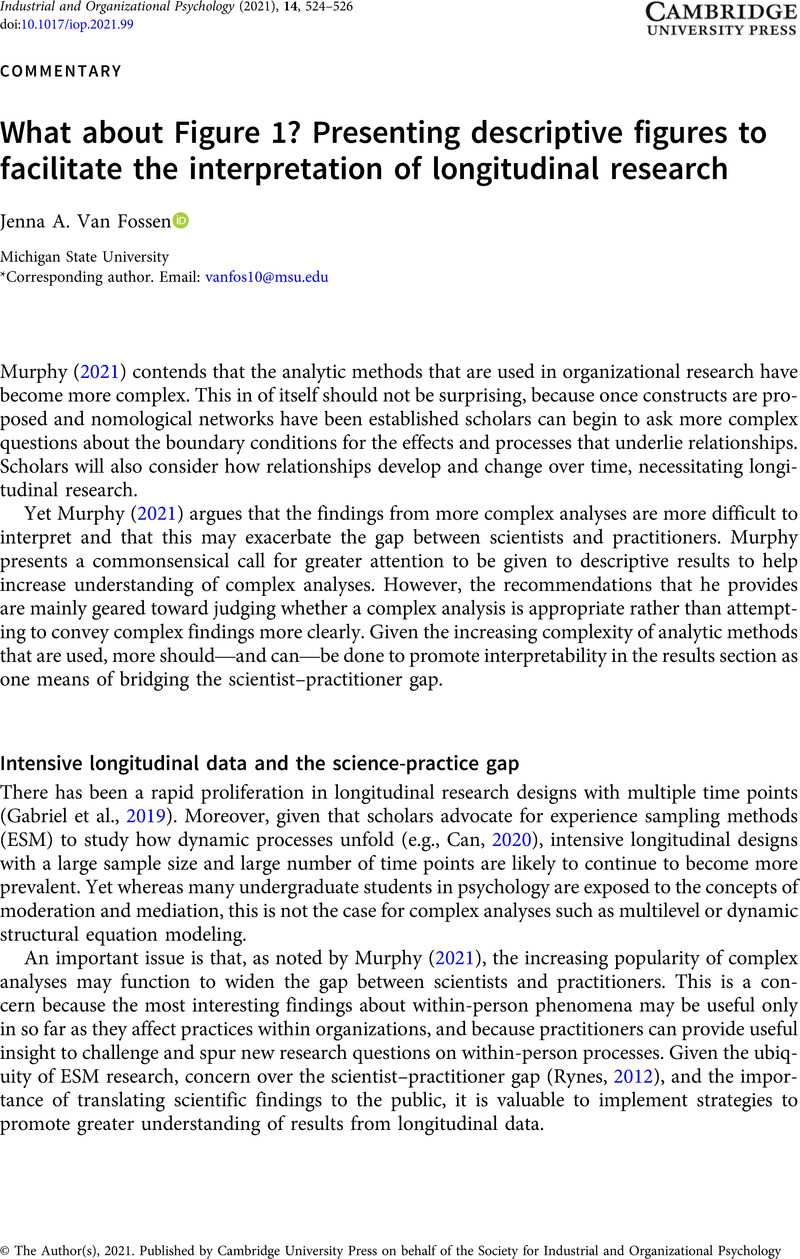No CrossRef data available.
Article contents
What about Figure 1? Presenting descriptive figures to facilitate the interpretation of longitudinal research
Published online by Cambridge University Press: 14 December 2021
Abstract
An abstract is not available for this content so a preview has been provided. Please use the Get access link above for information on how to access this content.

- Type
- Commentaries
- Information
- Copyright
- © The Author(s), 2021. Published by Cambridge University Press on behalf of the Society for Industrial and Organizational Psychology
References
Can, Ö. (2020, June 18–19). Studying dynamic processes by experience sampling methodology: Challenges and opportunities for organization research [Paper presentation]. 19th European Conference on Research Methodology for Business and Management Studies: ECRM 2019, Aveiro, Portugal.Google Scholar
Chance, B., Ben-Zvi, D., Garfield, J., & Medina, E. (2007). The role of technology in improving student learning of statistics. Technology Innovations in Statistics Education, 1(1).10.5070/T511000026CrossRefGoogle Scholar
Francis, K., Jacobsen, M., & Friesen, S. (2014). The use of graphics to communicate findings of longitudinal data in design-based research. Journal of Information Technology Education: Research, 13, 233–255.10.28945/2081CrossRefGoogle Scholar
Gabriel, A. S., Podsakoff, N. P., Beal, D. J., Scott, B. A., Sonnentag, S., Trougakos, J. P., & Butts, M. M. (2019). Experience sampling methods: A discussion of critical trends and considerations for scholarly advancement. Organizational Research Methods, 22(4), 969–1006.10.1177/1094428118802626CrossRefGoogle Scholar
Murphy, K. R., (2021). In praise of Table 1: The importance of making better use of descriptive statistics. Industrial and Organizational Psychology: Perspectives on Science and Practice, 14(4), 461–477.Google Scholar
Rynes, S. L. (2012). The research–practice gap in industrial–organizational psychology and related fields: Challenges and potential solutions. In S. W. J. Kozlowski (Ed.), Oxford handbook of organizational psychology (Vol. 1, pp. 409–452). Oxford University Press.Google Scholar
Smith, L. D., Best, L. A., Stubbs, D. A., Archibald, A. B., & Roberson-Nay, R. (2002). Constructing knowledge: The role of graphs and tables in hard and soft psychology. American Psychologist, 57(10), 749–761.10.1037/0003-066X.57.10.749CrossRefGoogle ScholarPubMed
Weissgerber, T. L., Winham, S. J., Heinzen, E. P., Milin-Lazovic, J. S., Garcia-Valencia, O., Bukumiric, Z., Savic, M. D., Garovic, V. D., & Milic, N. M. (2019). Reveal, don’t conceal: Transforming data visualization to improve transparency. Circulation, 140(18), 1506–1518.10.1161/CIRCULATIONAHA.118.037777CrossRefGoogle ScholarPubMed


